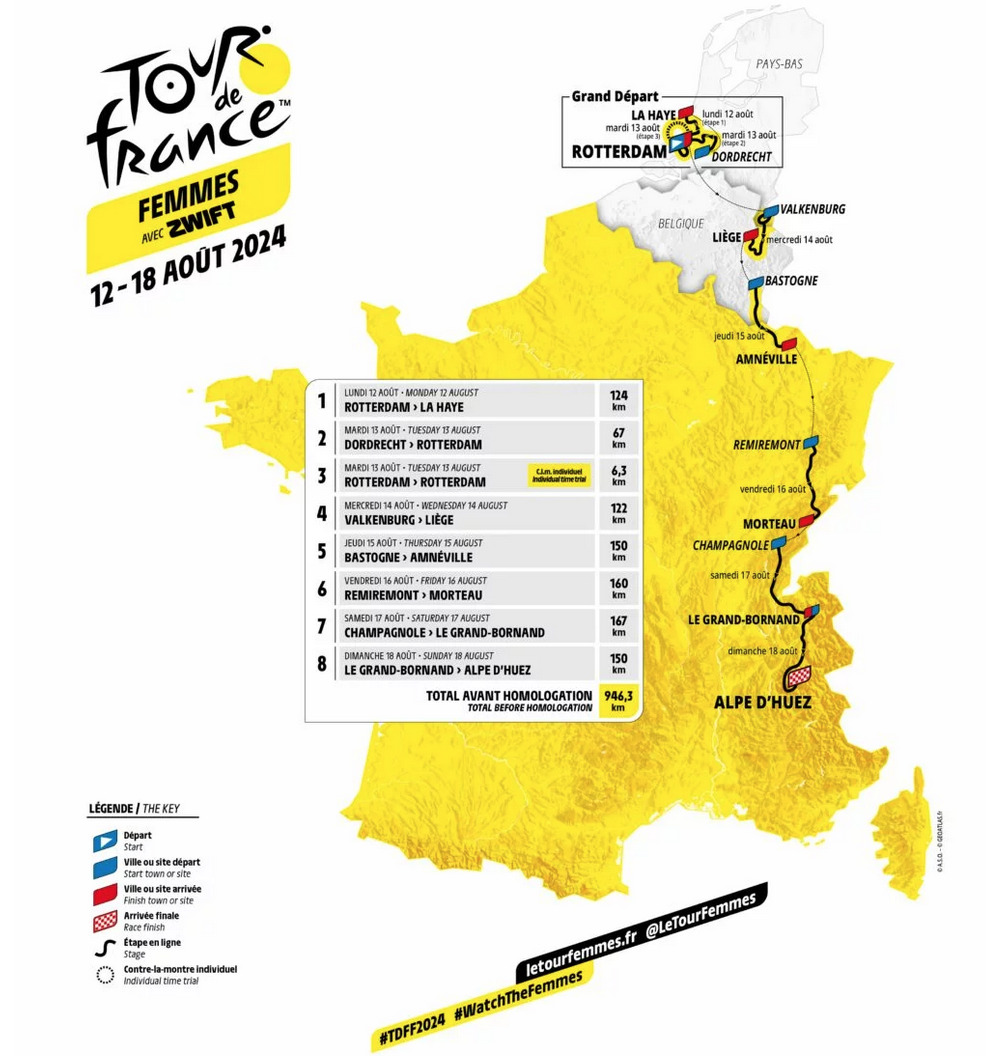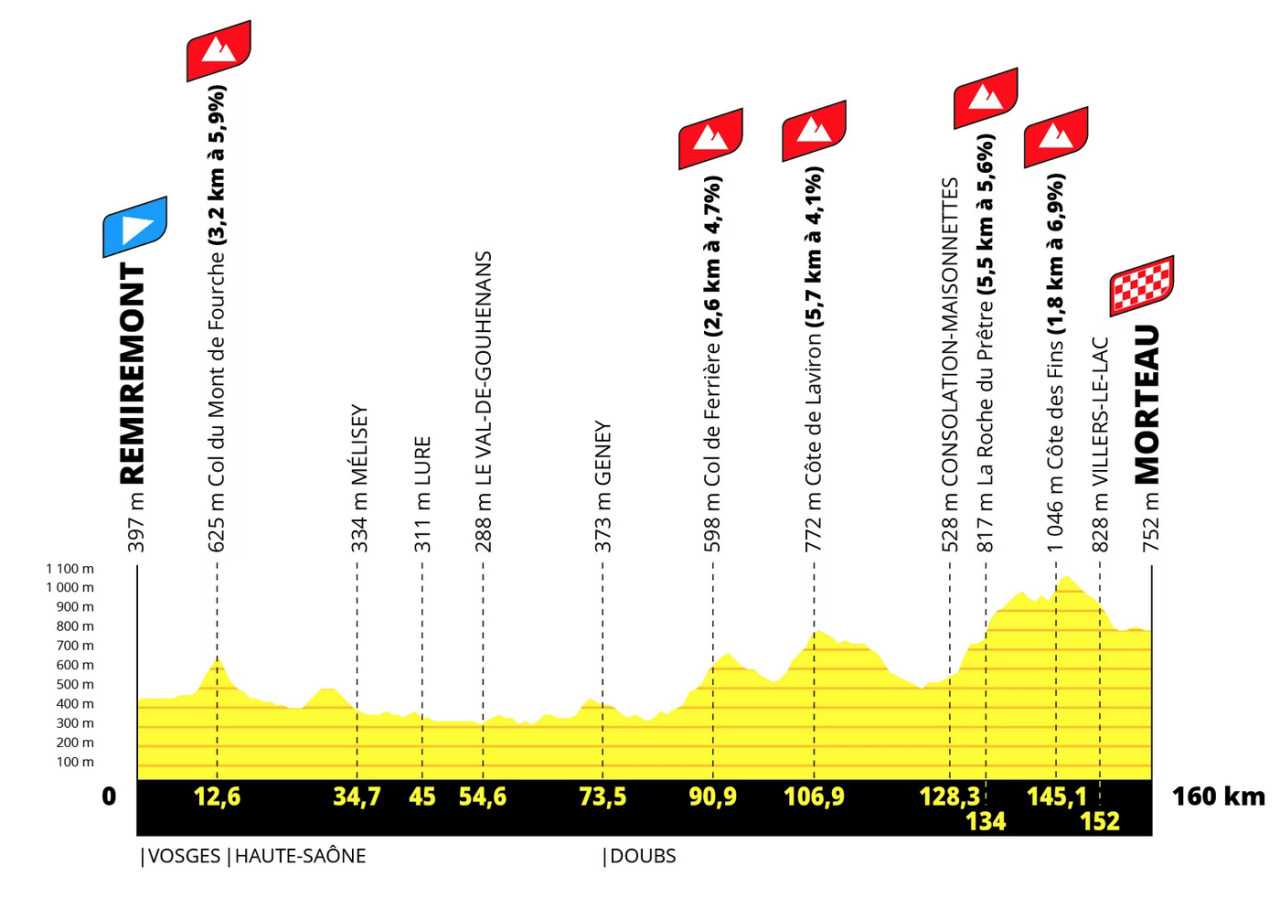The 2024 Tour de France Femmes route has been unveiled and it’s got something for everyone and plenty for Demi Vollering. Here’s a closer look at the stages.
The first change is the date move, no longer starting as the men’s Tour finishes, it’s moved to 12-18 August. This is a post-Olympic Games slot a massive summer of sports: the Tour de France, the Olympics and then the Tour de France Femmes… and the Vuelta a España too. Hopefully this distance from the men’s race doesn’t create a vacuum in the public consciousness, as the women have benefitted from the continuing festive mood. But nor can the race clash with the Olympics, for starters all the TV air time is taken up by the games. Big crowds come out to bike races in the Netherlands so the Rotterdam start makes sense.
Stage 1 and we hardly need the profile, it’s as flat as a pannenkoek but exposed to the wind and with all the Dutch street furniture too. Expect big crowds and a sprint finish.
Stage 2 is a the first of what used to be called a “split stage” or a “half stage” in that it will take place in the morning and is just 67km.
Stage 3 is a time trial and held in the afternoon. Just 6.3km as it twists through Rotterdam and takes in the Erasmus bridge, the symbol of the city. It embeds the TT as an essential component of the stage race but the short distance means it won’t dominate the race.
Stage 4 and is it August or April? The course that borrows from the Amstel Gold Race then Liège-Bastogne-Liège. Familiarity won’t make it easier, La Redoute, the Roche-aux-Faucons are tough climbs. It’s an important stage because of this and where punchy riders who find the limits on the Alpine climbs might want to put the pure climbers in trouble.
The race reaches France for Stage 5 as it goes from Bastogne to the Moselle region, it’s up and down all day and not a certain sprint finish, as you can see the last marked climb of the day isn’t at the top of the climb, although it’s all on a big road to Amnéville on the banks of the Moselle, for long at the centre of the area’s steel-making and now trying to get by as a spa town and tourist destination.
Stage 6 and let’s play word association. “Morteau!” and you say… … keen readers with pachyderm powers of recall might say the start town of Stage 2 of the men’s Tour de Romandie this year, notable because the Swiss race ventured over the border. But in France it’s famous for smoked sausages. Talking of which the race passes Mélisey so maybe Thibaut Pinot can be spotted with a roadside BBQ? The finish is hilly and scenic in the Jura mountains but, pending precise details, looks to avoid the gnarliest of backroads.
Stage 7 and both the Jura and the Alps. The start of the race tries had to avoid many of the Jura cols but uses the long Croix de Serra all the same, a relentless climb and then a lumpy middle section, ideal for a breakaway to establish and consolidate a lead. Then comes the climb to “Le Grand Bornand”, in quotes because the route actually goes through the town – where they had the La Course finish in 2018 – and out to Le Chinaillon, a village seven kilometres away and much closer to the top of the Col de la Colombière. It’s rarely steep but makes for a long climb.
If Alpe d’Huez gets all the headlines for obvious reasons, having the Col du Glandon on Stage 8 matters a lot too. This pass is as steep, but it’s longer and higher too it’s going to be very selective and even if the leaders don’t attack they’ll be sapped for the Alpe comes so the eventual gaps will be wider after the 21 and more hairpins. Whatever the previous seven stages have served up, this is bound to put the decisive seal on the result.
The Verdict
The classic format of a week long stage race, as in a flat start that progressively gets more selective before a blockbuster final day. In fact the contrast is remarkable as there are no climbs to award the mountains jersey on the opening two days in the Netherlands and later on the race goes over mountain passes that don’t even count for the mountains competition because they’re presumably thought of as bumps along the way.
Maybe racing around Rotterdam isn’t the stuff of dreams – even Dutch cyclists might concede they like take their bikes on holiday to France rather than Rotterdam – but the foreign start makes perfect sense given the Paris Olympics can crowd out le Tour and the race ought to bring out large crowds.
Demi Vollering is the obvious pick for the overall win but the short time trial isn’t ruinous for rivals. Maybe the race is open to a pure climber like Gaia Realini too because the Glandon and Alpe d’Huez are giants but all the same, Vollering took almost two minutes on the Tourmalet.











How does this all mix with olympics cycling events? Will some use it as training or stay away??
Lotte Kopecky has already stated that riding the Tour will be difficult for her, because it starts the day after the Omnium event which she is targeting…I’d be surprised if she doesn’t show up, but she may not be in her best shape being fatigued from the track
As Davesta says, maybe an overlap with the track. But the women’s road race (and men) is on the opening weekend of the games, so plenty of time to recover and refocus with the Tour starting just over two weeks after. Fingers crossed it just means we see riders in peak form.
Amnéville is, as IR suggests, a getting-by spa town with indoor ski slope (built on a slag bank), zoo, casino, olympic pool and much else, all driven by former mayor, Jean Kiffer, with little democratic control and some confused accounting. The town though is much more – like this whole area – a dormitory town for those working in Luxembourg.
It will be curious to see the endless rows of former miner’s houses in Rombas, Moyeuvre, Gandrange, a counterpoint to typical rural France and slightly less picturesque backdrop for the cyclists.
It’s good to see the race continuing what’s been a winning formula so far, with a mix of stage profiles and a famous headline climb to end the race…the split stage is a nice addition, and presumably done to allow the race to continue to have 8 stages plus finish on a Sunday, despite having to start on the Monday after the olympics. But I do hope the race will start to lengthen in the coming years – perhaps a 10 day race for a couple of years, before extending to 2 weeks as the women’s peloton continues to deepen in talent.
The reason female ‘grand tours’ are not at least two weeks long has absolutely nothing to do with women’s abilities to do a race of that distance.
Cycling is stuck in the 1950s, and the UCI’s mandatory distances for female races are sexist, pure and simple.
Giro Donne already had 12-13 stages, so it’s not like it can’t be done, obviously the 50s had a break in the early 2000s
It’s a tricky one. They want to extend the race but how? You can’t run the race at the same time as the men so the Tour Femmes has to start on the final day of the men’s race, but if it grows to a 10 day race you don’t want it to stop mid-week either, it wouldn’t get the same audience (you could, and have the big GC stages at the weekend and then wind down with a sprint stage etc). Maybe it could go to 10 days with a midweek start. The plan anyway is to keep it growing but depends on demand from host towns and if enough broadcasters support it (for all the channels that show the men’s race, only a few channels show the women’s race live).
Demi Vollering…
Demi like in half?
Volle like in full?
Ring like in ring/circle/round/Runde?
Some would maybe call the tour a round-trip or Rundfahrt? And the Tour de Femmes is covering about half of France?
Mid August obviously belongs to Demi Vollering.
Cause it’s a Zwift Tour avec some France
How come Zwift get naming rights, while Crédit Lyonnais don’t? Should by rights be Le Tour de France avec LCL.
Stages 2 and 3, why not stages 2a and 2b?
Cause then it’s only a 7 stage Tour?
Exactly. Also split stages are banned under UCI rules, I think there’s been a waiver but all the more reason to call it Stage 2 and Stage 3.
At least it’s still called a women’s tour! I see some women’s races billed as ‘ladies’ races (e.g.Baloise Ladies Tour). Are these for ladies only? Do they have to prove ladylike behaviour before being allowed to enter?
I suppose we could then have ‘gentlemen’s races’, with the UCI defining gentlemanly attributes? A very polite peloton…?
Are there any other “Ladies Tours”? There was Ladies Tour of Norway but it grew into Tour of Scandinavia.
Anyway, few non-native speakers notice the nuance, “ladies” is seen simply as a neutral synonym for “women” – just like there is no difference between “men” and “gentlemen” when they are used as signs on a door…
If the races have a prefix or suffix it’s usually “women” as Tour de France Femmes, Giro Donne, Vuelta, Women’s Tour etc but a handful of races use the “ladies” term, eg the Amstel, think it’s just something that got lost in translation?
Looks like an amazing race. I can’t wait for next summer’s racing.
I don’t think this race “only” being 7 days is an issue with an easy fix. Yes, the UCI has their stupid restrictions BUT if it made commercial sense for ASO to make this 3-weeks then it would be. The ASO is juggling complaints from fans while also making this commercially viable to them.
This year’s circuit has a lot of really challenging stages, and will be a very interesting one to follow.